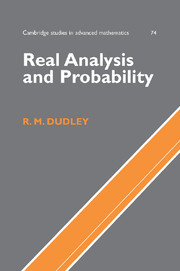Book contents
- Frontmatter
- Contents
- Preface to the Cambridge Edition
- 1 Foundations; Set Theory
- 2 General Topology
- 3 Measures
- 4 Integration
- 5 Lp Spaces; Introduction to Functional Analysis
- 6 Convex Sets and Duality of Normed Spaces
- 7 Measure, Topology, and Differentiation
- 8 Introduction to Probability Theory
- 9 Convergence of Laws and Central Limit Theorems
- 10 Conditional Expectations and Martingales
- 11 Convergence of Laws on Separable Metric Spaces
- 12 Stochastic Processes
- 13 Measurability: Borel Isomorphism and Analytic Sets
- Appendix A Axiomatic Set Theory
- Appendix B Complex Numbers, Vector Spaces, and Taylor's Theorem with Remainder
- Appendix C The Problem of Measure
- Appendix D Rearranging Sums of Nonnegative Terms
- Appendix E Pathologies of Compact Nonmetric Spaces
- Author Index
- Subject Index
- Notation Index
- References
5 - Lp Spaces; Introduction to Functional Analysis
Published online by Cambridge University Press: 06 July 2010
- Frontmatter
- Contents
- Preface to the Cambridge Edition
- 1 Foundations; Set Theory
- 2 General Topology
- 3 Measures
- 4 Integration
- 5 Lp Spaces; Introduction to Functional Analysis
- 6 Convex Sets and Duality of Normed Spaces
- 7 Measure, Topology, and Differentiation
- 8 Introduction to Probability Theory
- 9 Convergence of Laws and Central Limit Theorems
- 10 Conditional Expectations and Martingales
- 11 Convergence of Laws on Separable Metric Spaces
- 12 Stochastic Processes
- 13 Measurability: Borel Isomorphism and Analytic Sets
- Appendix A Axiomatic Set Theory
- Appendix B Complex Numbers, Vector Spaces, and Taylor's Theorem with Remainder
- Appendix C The Problem of Measure
- Appendix D Rearranging Sums of Nonnegative Terms
- Appendix E Pathologies of Compact Nonmetric Spaces
- Author Index
- Subject Index
- Notation Index
- References
Summary
The key idea of functional analysis is to consider functions as “points” in a space of functions. To begin with, consider bounded, measurable functions on a finite measure space (X, S, μ) such as the unit interval with Lebesgue measure. For any two such functions, f and g, we have a finite integral ∫ f g d μ = ∫ f(x)g(x)d μ(x). If we consider functions as vectors, then this integral has the properties of an inner product or dot product (f, g): it is nonnegative when f = g, symmetric in the sense that (f, g)≡ (g, f), and linear in f for fixed g. Using this inner product, one can develop an analogue of Euclidean geometry in a space of functions, with a distance d(f, g) = (f – g, f – g)½, just as in a finite-dimensional vector space. In fact, if μ is counting measure on a finite set with k elements, (f, g) becomes the usual inner product of vectors in ℝk. But if μ is Lebesgue measure on [0, 1], for example, then for the metric space of functions with distance d to be complete, we will need to include some unbounded functions f such that ∫ f2 dμ < ∞. Along the same lines, for each p > 0 and μ there is the collection of functions f which are measurable and for which ∫ |f|p d μ < ∞. This collection is called p or p(μ).
- Type
- Chapter
- Information
- Real Analysis and Probability , pp. 152 - 187Publisher: Cambridge University PressPrint publication year: 2002



